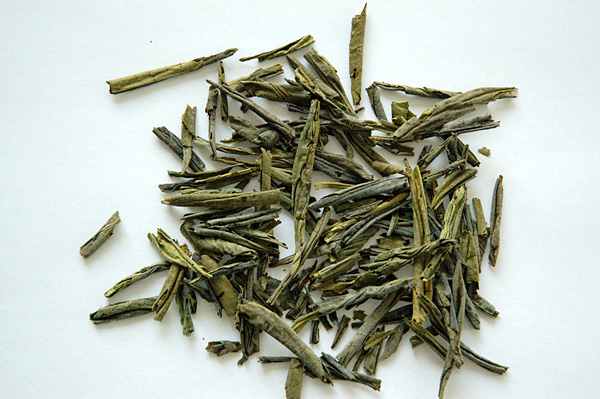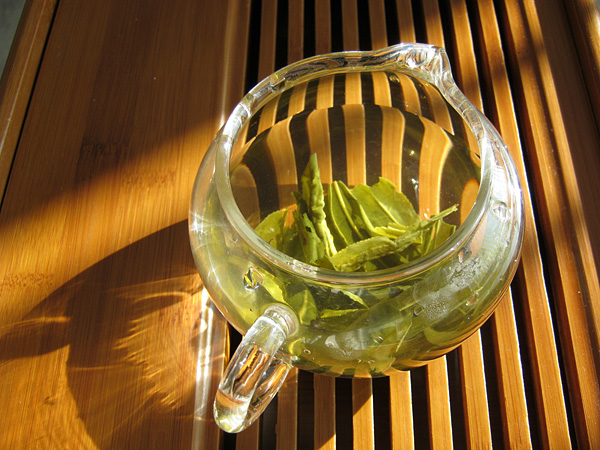Lu'an Guapian on:
[Wikipedia]
[Google]
[Amazon]

 Lu'an Melon Seed (; pronounced ), also known as Lu'an Leaf, is a
Lu'an Melon Seed (; pronounced ), also known as Lu'an Leaf, is a
Spring Lin Chinese Tea. ''The Classic of Tea'' was the first book about general tea knowledge, and contained a brief introduction about tea categories and how to prepare tea. It was written by
, Green Tea House. The Chinese Christian Xu Guangqi (1562–1633), who was also a well-known scientist writing in his ''Agricultural Encyclopedia'' that "laminar tea from Lu'an Prefecture is a top-grade tea". Lu'an Melon Seed Tea was a type of ''gong cha'' ("tribute tea") to the imperial family during the

 Lu'an Melon Seed (; pronounced ), also known as Lu'an Leaf, is a
Lu'an Melon Seed (; pronounced ), also known as Lu'an Leaf, is a green tea
Green tea is a type of tea that is made from '' Camellia sinensis'' leaves and buds that have not undergone the same withering and oxidation process which is used to make oolong teas and black teas. Green tea originated in China, and since the ...
from Lu'an City, Anhui
Anhui , (; formerly romanized as Anhwei) is a landlocked province of the People's Republic of China, part of the East China region. Its provincial capital and largest city is Hefei. The province is located across the basins of the Yangtze River ...
Province, China
China, officially the People's Republic of China (PRC), is a country in East Asia. It is the world's most populous country, with a population exceeding 1.4 billion, slightly ahead of India. China spans the equivalent of five time zones and ...
. This is a famous green tea and is listed on virtually all lists of famous Chinese teas. The literal translation for Lu'an Guapian Tea is Lu'an Melon Seed Tea.
Lu'an Melon Seed Tea's name is derived from the shape of the processed tea leaves, which are flat and oval and resemble a melon seed. Unlike most green teas which use the new buds in making tea, Lu'an Melon Seed Tea uses the second leaf on the branch. Each leaf's central vein is removed and the leaves are pan fried and shaped to stop oxidizing enzymes and dry the tea.Chinese-Tea-Culture.com, , www.chinese-tea-culture.com
History
According to historical texts, Lu'an Melon Seed Tea was first recorded in ''The Classic of Tea
''The Classic of Tea'' or ''Tea Classic'' () is the first known monograph on tea in the world, by Chinese writer Lu Yu between 760 CE and 762 CE, during the Tang dynasty. Lu Yu's original manuscript is lost; the earliest editions available date ...
''.Liu’an GuapianSpring Lin Chinese Tea. ''The Classic of Tea'' was the first book about general tea knowledge, and contained a brief introduction about tea categories and how to prepare tea. It was written by
Lu Yu
Lu Yu (; 733–804) or Lu Ji (陆疾), courtesy name Jici (季疵) was a Chinese tea master and writer. He is respected as the Sage of Tea for his contribution to Chinese tea culture. He is best known for his monumental book ''The Classic of ...
(733–804 CE) during the Tang dynasty
The Tang dynasty (, ; zh, t= ), or Tang Empire, was an Dynasties in Chinese history, imperial dynasty of China that ruled from 618 to 907 AD, with an Zhou dynasty (690–705), interregnum between 690 and 705. It was preceded by the Sui dyn ...
(618–907 CE). In contrast to the processing methods for other kinds of green tea such as Longjing, Lu'an Melon Seed Tea is a baked green tea which causes the taste of the tea to be different from other types of green tea in China.
During the Ming dynasty
The Ming dynasty (), officially the Great Ming, was an Dynasties in Chinese history, imperial dynasty of China, ruling from 1368 to 1644 following the collapse of the Mongol Empire, Mongol-led Yuan dynasty. The Ming dynasty was the last ort ...
(1368–1644), Lu'an Melon Seed Tea was widely used to prevent sunstroke by the Chinese.Liu An Melon Seed tea, Guapian History, Green Tea House. The Chinese Christian Xu Guangqi (1562–1633), who was also a well-known scientist writing in his ''Agricultural Encyclopedia'' that "laminar tea from Lu'an Prefecture is a top-grade tea". Lu'an Melon Seed Tea was a type of ''gong cha'' ("tribute tea") to the imperial family during the
Qing dynasty
The Qing dynasty ( ), officially the Great Qing,, was a Manchu-led imperial dynasty of China and the last orthodox dynasty in Chinese history. It emerged from the Later Jin dynasty founded by the Jianzhou Jurchens, a Tungusic-speak ...
(1644–1911). It was enjoyed by the Guangxu Emperor (r. 1878–1908) and Empress Dowager Cixi (r. 1861–1908). Lu'an Melon Seed Tea was also mentioned about 80 times by the writer Cao Xueqin (1715–1763) in his novel ''Dream of the Red Chamber
''Dream of the Red Chamber'' (''Honglou Meng'') or ''The Story of the Stone'' (''Shitou Ji'') is a novel composed by Cao Xueqin in the middle of the 18th century. One of the Four Great Classical Novels of Chinese literature, it is known for ...
''.
See also
* Chinese tea *Tea processing
Tea processing is the method in which the leaves from the tea plant '' Camellia sinensis'' are transformed into the dried leaves for brewing tea.
The categories of tea are distinguished by the processing they undergo. In its most general form, t ...
* China Famous Tea
References
{{teas Green tea Chinese tea grown in Anhui Chinese teas